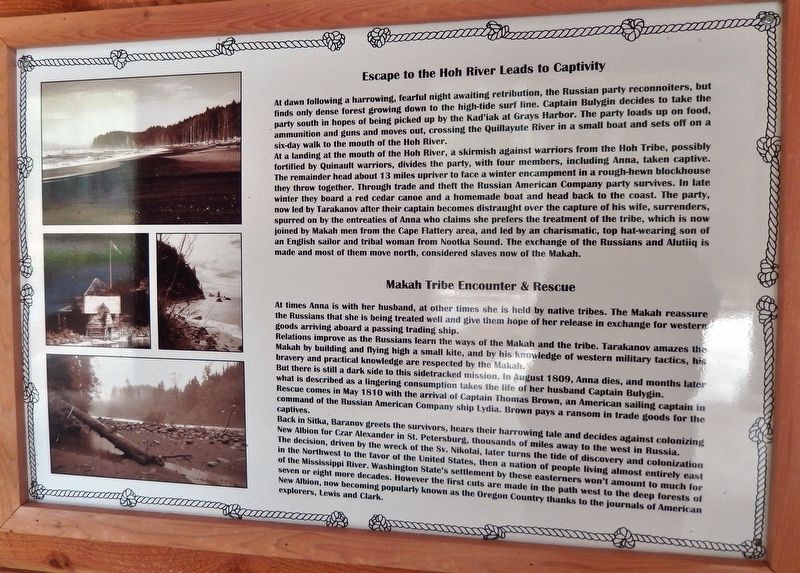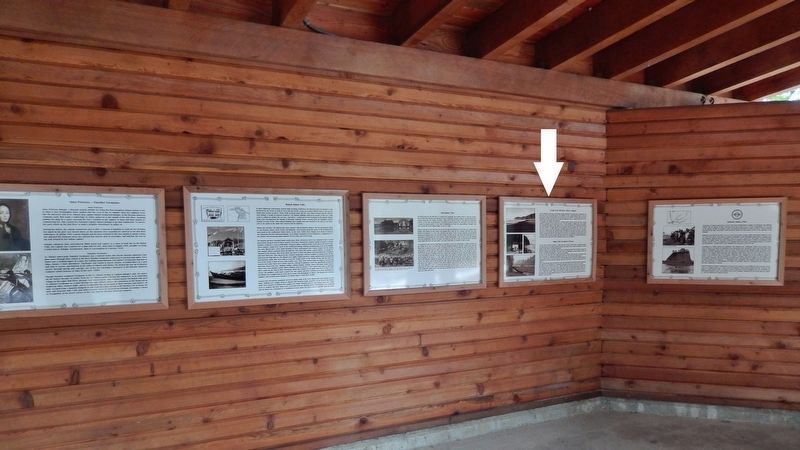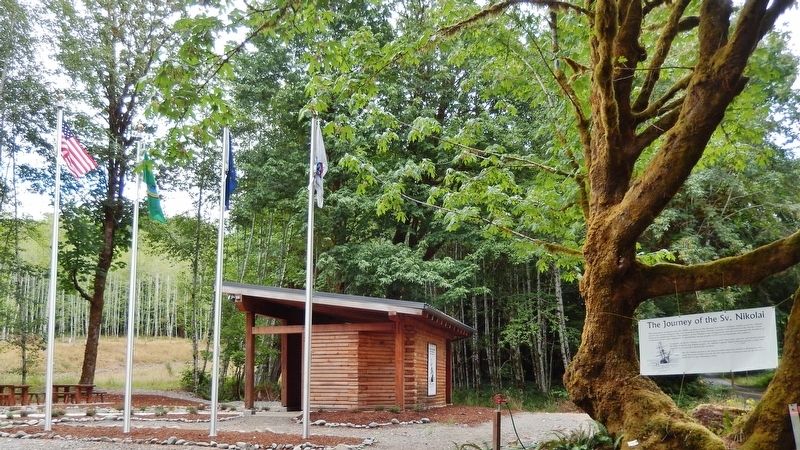Near Forks in Jefferson County, Washington — The American West (Northwest)
Escape to the Hoh River Leads to Captivity
Makah Tribe Encounter & Rescue
Escape to the Hoh River Leads to Captivity
At dawn following a harrowing, fearful night awaiting retribution, the Russian party reconnoiters, but finds only dense forest growing down to the high-tide surf line. Captain Bulygin decides to take the party south in hopes of being picked up by the Kad'iak at Grays Harbor. The party loads up on food, ammunition and guns and moves out, crossing the Quillayute River in a small boat and sets off on a six-day walk to the mouth of the Hoh River.
At a landing at the mouth of the Hoh River, a skirmish against warriors from the Hoh Tribe, possibly fortified by Quinault warriors, divides the party, with four members, including Anna, taken captive. The remainder head about 13 miles upriver to face a winter encampment in a rough-hewn blockhouse they throw together. Through trade and theft the Russian American Company party survives. In late winter they board a red cedar canoe and a homemade boat and head back to the coast. The party, now led by Tarakanov after their captain becomes distraught over the capture of his wife, surrenders, spurred on by the entreaties of Anna who claims she prefers the treatment of the tribe, which is now joined by Makah men from the Cape Flattery area, and led by a charismatic, top hat-wearing son of an English sailor and tribal woman from Nootka Sound. The exchange of the Russians and Alutiiq is made and most of them move north, considered slaves now of the Makah.
Makah Tribe Encounter & Rescue
At times Anna is with her husband, at other times she is held by native tribes. The Makah reassure the Russians that she is being treated well and give them hope of her release in exchange for goods arriving aboard a passing trading ship.
Relations improve as the Russians learn the ways of the Makah and the tribe. Tarakanov amazes the Makah by building and flying high a small kite, and by his knowledge of western military tactics, his bravery and practical knowledge are respected by the Makah.
But there is still a dark side to this sidetracked mission. In August 1809, Anna dies, and months later what is described as a lingering consumption takes the life of her husband Captain Bulygin.
Rescue comes in May 1810 with the arrival of Captain Thomas Brown, an American sailing captain in command of the Russian American Company ship Lydia. Brown pays a ransom in trade goods for the captives.
Back in Sitka, Baranov greets the survivors, hears their harrowing tale and decides against colonizing New Albion for Czar Alexander in St. Petersburg, thousands of miles away to the west in Russia. The decision, driven by the wreck of the Sv. Nikolai, later turns the tide of discovery
and colonization in the Northwest to the favor of the United States, then a nation of people living almost entirely east of the Mississippi River. Washington State's settlement by these easterners won't amount to much for seven or eight more decades. However the first cuts are made in the path west to the deep forests of New Albion, now becoming popularly known as the Oregon Country thanks to the journals of American explorers, Lewis and Clark.
Erected 2015 by Association of Washington Generals, The Peterson Family, State of Washington, State of Alaska, and American Legion Post 106.
Topics. This historical marker is listed in these topic lists: Exploration • Native Americans • Settlements & Settlers. A significant historical month for this entry is May 1810.
Location. 47° 49.021′ N, 124° 9.131′ W. Marker is near Forks, Washington, in Jefferson County. Marker can be reached from Upper Hoh Road, 0.1 miles east of Linder Creek Lane, on the left when traveling east. Marker is located in the "Journey of the Sv. Nikolai" interpretive kiosk, on the north side of Upper Hoh Road. Touch for map. Marker is at or near this postal address: 5833 Upper Hoh Road, Forks WA 98331, United States of America. Touch for directions.
Other nearby markers. At least 7 other markers are within 9 miles of this marker, measured as the crow flies. Hoh Indian Tribe (here, next to this marker); Makah Indian Tribe (here, next to this marker); Sv. Nikolai Mission (here, next to this marker); Anna Petrovna - Timothei Tarakanov (here, next to this marker); Quileute Indian Tribe (here, next to this marker); Fort Ross, California - Sitka Castle, Alaska - Fort Elisabeth, Kaua’i, Hawai’i (here, next to this marker); Rain Forest Monarch (approx. 8.4 miles away).
More about this marker. Marker is a framed interpretive panel mounted at eye-level on the kiosk wall. This monument commemorates the 1808 expedition of the Russian American Company sailing vessel Sv. Nikolai and its crew of 22 explorers who were stranded when their 45-foot schooner went aground on the Pacific Coast north of the Quillayute River.
Related markers. Click here for a list of markers that are related to this marker. The Journey of the Sv. Nikolai
Also see . . . Russian Castaways Among the Indians. When the Russians returned to the coast hoping that they would find some way of being rescued, they found that the wife of their leader had been sold by the Hoh to the Makah. When she found that they were planning a raid to rescue her, she rejected the idea. Instead, she urged the Russians to surrender to her captors. Timofei Tarakanov reports it this way: “In horror, distress, and anger, we heard her say firmly that she was satisfied with her condition, did not want to join us, and that she advised us to surrender ourselves to this people.” (Submitted on February 6, 2019, by Cosmos Mariner of Cape Canaveral, Florida.)
Credits. This page was last revised on February 10, 2019. It was originally submitted on February 5, 2019, by Cosmos Mariner of Cape Canaveral, Florida. This page has been viewed 243 times since then and 20 times this year. Photos: 1, 2, 3. submitted on February 6, 2019, by Cosmos Mariner of Cape Canaveral, Florida. • Bill Pfingsten was the editor who published this page.


